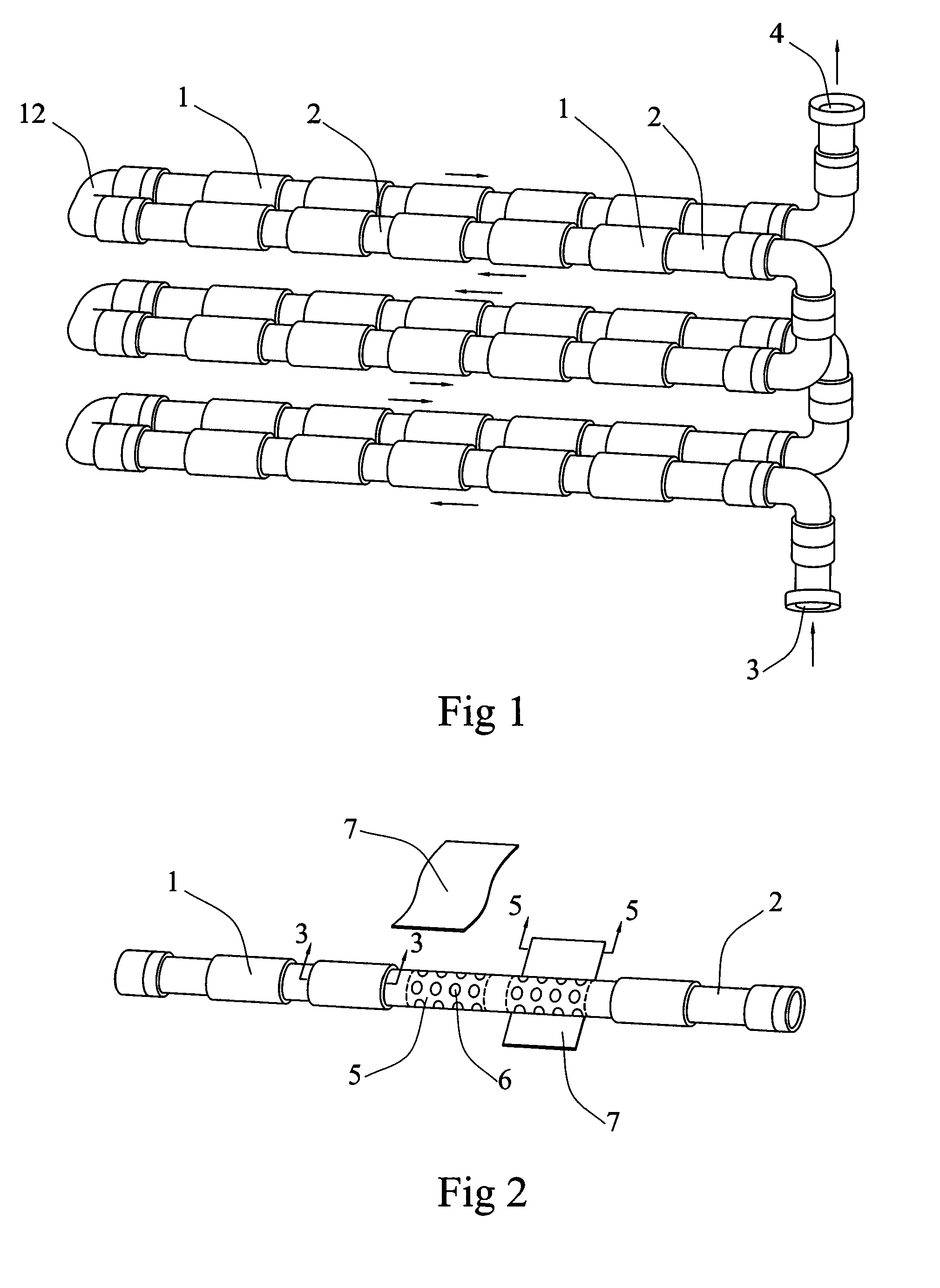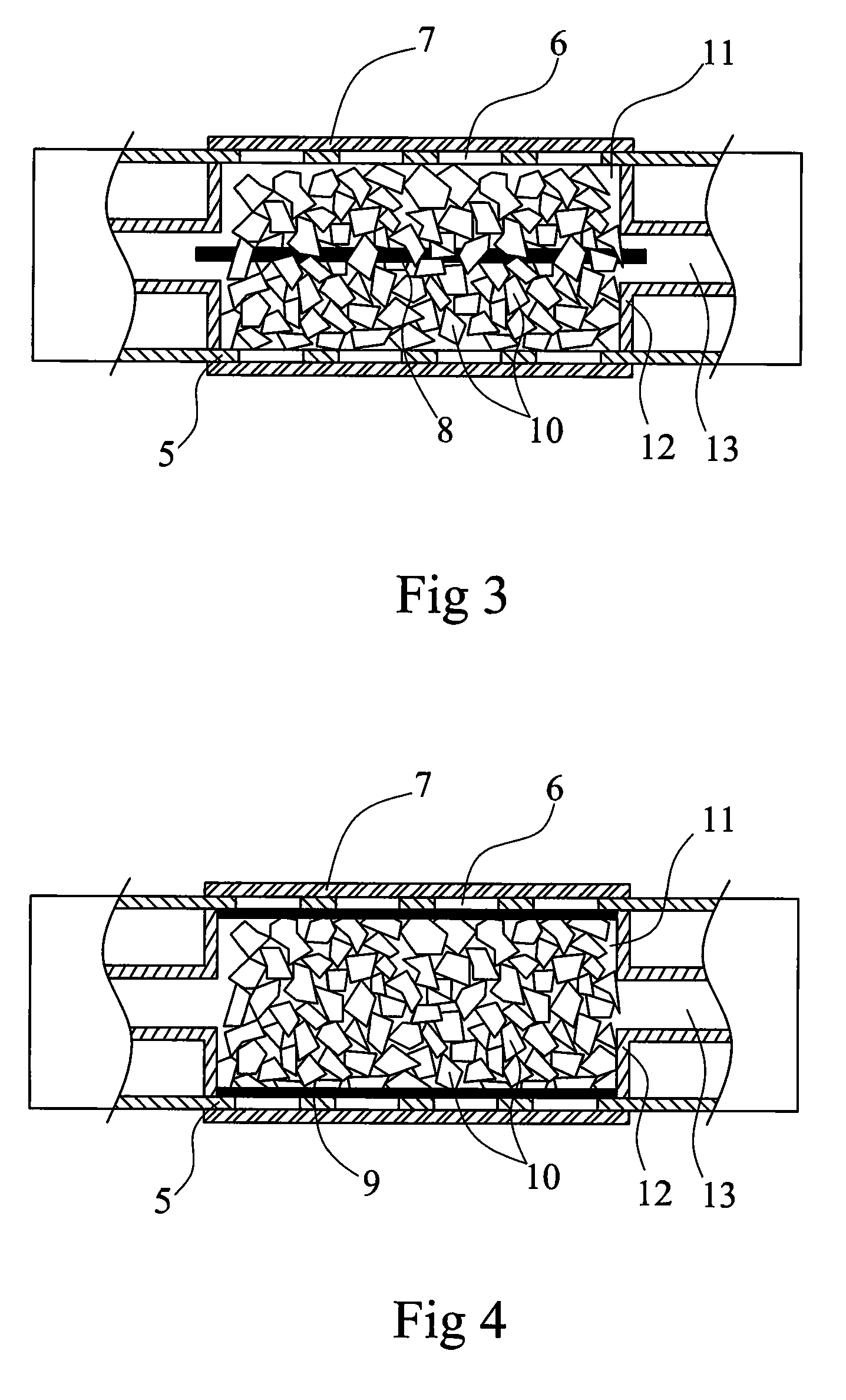Microbial fuel cell stack
a fuel cell and microorganism technology, applied in the field of microorganism fuel cell stacks, can solve the problems of difficult to prevail in stackable air-cathode single-chamber mfc, difficult to output the required voltage and current, and adopt an expensive proton-exchange membrane, etc., to achieve compact structure, increase the effect of voltage and current of the mfc stack, and occupie less spa
- Summary
- Abstract
- Description
- Claims
- Application Information
AI Technical Summary
Benefits of technology
Problems solved by technology
Method used
Image
Examples
embodiment i
[0031]As shown in FIG. 1 and FIG. 2. A 5 cm-diameter PVC (polyvinylchloride) pipe is fabricated into frames 5 having a length of 13 cm segment by segment. Each PVC pipe is fabricated into five microbial fuel cells 1. Because of the continuity of the pipes 2, the anode chambers of the five microbial fuel cells 1 connect head to tail sequentially and interconnect each other. In the embodiment shown in FIG. 1, two PVC pipes are arranged in parallel to form one layer of the MFC stack. In FIG. 1, six PVC pipes are interconnected by elbows 12 to form three layers. The ends of the first PVC pipe and the last PVC pipe respectively have a feeding port 3 and a discharging port 4. Thus, the thirty pieces of microbial fuel cells 1 form a three-layer MFC stack. Wastewater enters the MFC stack from the feeding port 3, flows through all the microbial fuel cells 1 and then drains out from the discharging port 4. In FIG. 1, the arrows indicate the flow direction of the wastewater.
[0032]As shown in F...
embodiment ii
[0035]Embodiment II is different from Embodiment I in the structures of the anode chamber and the cathode. Refer to FIG. 4. A PVC pipe with 23 cm in length and 5 cm in diameter is used as the frame 5. On the frame 5 is perforated holes 6 with a diameter of 1 cm and a hole density of 1000 holes / m2. A 13 cm long, 14.5 cm wide and 0.5 cm thick graphite felt 9 is rolled up to have a cylinder form. The cylindrical graphite felt 9 is placed in the pipe and filled up with graphite grains 10. A titanium wire connects with the graphite felt 9 to function as the conductive wire of the anode. The graphite felt 9 of one MFC is connected to the cathode 7 of next MFC with the titanium wire sequentially to assemble thirty pieces of MFCs into a cascade MFC stack.
[0036]Refer to FIG. 6 for the structure of a cathode. In Embodiment II, the cathode 7 is a fabric-based cathode and includes a waterproof air-permeable layer 75, a fabric-based layer 74 and a conductive catalytic layer 73. A piece of 14.5 c...
embodiment iii
[0039]Embodiment III is different from Embodiment II in the material of the cathode. A piece of 29 cm long, 35 cm wide and 0.5 mm thick denim is used as the fabric-based layer 74. The cathode 7 is fabricated according to the following steps: dissolving 3.0 g PTFE in 40.0 ml N-methyl-2-pyrrolidone, uniformly stirring the mixture, evenly applying the mixture onto one surface of the denim, air-drying the coated denim for 10 hours, and baking the air-dried drying coated denim at a temperature of 70° C. for 2 hours, whereby the coated denim has a PTPE density of 3.0 mg / cm2; ultrasonically dispersing the mixture of 1.0 g CoTMPP (the oxygen reduction catalytic) and 25.0 g graphite-based conductive paint for 15 minutes into a slurry; evenly applying the slurry on the other surface of the denim, air-drying the double-coated denim for 10 hours, and baking air-dried double-coated denim at a temperature of 70° C. for 2 hours, whereby the double-coated denim has a CoTMPP density of 1.0 mg / cm2.
PUM
| Property | Measurement | Unit |
|---|---|---|
| diameter | aaaaa | aaaaa |
| length | aaaaa | aaaaa |
| diameter | aaaaa | aaaaa |
Abstract
Description
Claims
Application Information
 Login to View More
Login to View More - R&D
- Intellectual Property
- Life Sciences
- Materials
- Tech Scout
- Unparalleled Data Quality
- Higher Quality Content
- 60% Fewer Hallucinations
Browse by: Latest US Patents, China's latest patents, Technical Efficacy Thesaurus, Application Domain, Technology Topic, Popular Technical Reports.
© 2025 PatSnap. All rights reserved.Legal|Privacy policy|Modern Slavery Act Transparency Statement|Sitemap|About US| Contact US: help@patsnap.com



